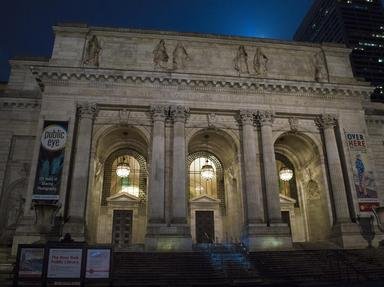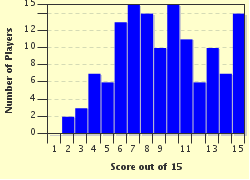Quiz Answer Key and Fun Facts
1. This American writer was born in 1835 shortly after the appearance of Halley's Comet and died 75 years later, a day after the comet returned. He worked as a printer, a river pilot, a miner, and a journalist and was even an amateur scientist and inventor as well. His name would be immediately obvious if I mentioned his best-known works, so can you recognize him from these titles instead: "The Innocents Abroad", "Roughing It", "Personal Recollections of Joan of Arc", "Fennimore Cooper's Literary Offenses", and the posthumously published "Letters from the Earth"?
2. This American regionalist writer who focused on California's gold rush era was born in Albany, New York, in 1836 and moved West to California with his widowed mother to find work as a journalist at age eighteen. By 1864, he was Secretary of the California Mint, a job which afforded him much time to write stories like "The Outcasts of Poker Flat", which is about a gambler who is hypocritically escorted out of town as a criminal only after others have lost money to him and then later takes his life after he determines his luck has run out during a blizzard. Who is this writer, who also wrote one of the finest parodies of Doyle's Sherlock Holmes stories--"The Stolen Cigar Case" featuring Hemlock Jones?
3. In 1890, a short story appeared in the "San Francisco Examiner" that told of a Southern planter and Confederate sympathizer who becomes the victim of entrapment when he tries to burn a bridge controlled by Union forces. Just as Peyton Farquhar is to be hanged from the very bridge he attempted to destroy, the rope breaks! He plummets into the water, swims for his life while avoiding bullets from the soldiers, treks thirty miles through a forest, and experiences strange phenomena along the way. Then, suddenly, the reader discovers that the entire escape was Farquhar's hallucinatory fantasy and that he is truly dead and hanging from the end of the rope. What story by Ambrose Bierce is this?
4. While his brother achieved fame as one of America's greatest philosophers and psychologists, this writer excelled in the field of literature, being nominated for the Nobel Prize three different times. He is celebrated today for his achievements in literary realism as well as his psychological realism, which depended on the masterful creation and use of interior monologue. Who was this author of rather complex novels such as "The Wings of the Dove", "The Ambassadors", and "The Golden Bowl"?
5. Born in St. Louis, Missouri, in 1850, this Southern regionalist married at nineteen and spent ten years in New Orleans before her husband died and she returned to St. Louis. From her Louisiana experiences came the material and influence she needed to write 150 stories (such as "Desiree's Baby" about a slave owner who rejects his wife after their child is discovered to be bi-racial, only to realize later after she has drowned herself and their child that he is the one who is bi-racial) and three novels (such as "The Awakening" about a married woman who begins to see herself as someone having an identity other than just a wife and mother and as having legitimate sexual feelings). Who is this author?
6. Mary E. Wilkins got married for the first time at age forty-nine to Dr. Charles Freeman, and eighteen years later had to institutionalize her husband due to his severe alcoholism. Her independent life in the northeast United States inspired her 1891 collection of what many consider her best fiction. The title story is about a woman who calls off her engagement to a man she has waited fourteen years to marry, and she is perfectly serene with her decision to live without a man in her life. What is the title of Mary E. Wilkins Freeman's short story collection, which also contains "The Revolt of 'Mother'"?
7. In response to the growing inequality between whites and blacks educationally, socially, politically, and economically, Booker T. Washington published "Up from Slavery" in 1900. In this influential book, Washington asked his fellow African Americans to "Cast down your bucket where you are" into productive and prosperous professions. He believed that education and good economic standing among black people was essential to their being perceived as worthy of rights. However, another prominent African American disagreed with Washington, for he believed that until equal rights were recognized and protected, black people could never achieve what Washington wanted them to achieve. Rights had to come first. Who was this author of the 1903 book "The Souls of Black Folk"?
8. In 1887, when the short story "The Goophered Grapevine" appeared in the "Atlantic Monthly", readers believed its African-American author to be white because of the frame format of the story. Uncle Julius speaks with the dialect of an uneducated slave and spins a tale about a slave who became cursed after eating bewitched grapes; however, surrounding this tale is the story told by a Northern opportunist seeking to invest in property, and his words represent the sophistication of an educated white man. What is the name of this author who became the first writer of African American descent to be taken seriously by the white press?
9. A frequently anthologized story, "Editha" is about a young woman who delivers an ultimatum to her fiance by telling him she cannot marry him unless he enlists as a soldier to fight in the Spanish American War. He dies at the beginning of his very first battle, Editha is lambasted by George's mother, and soon returns after a moment of guilt to her naive view of a world in which women should be won by men who have proved themselves heroic. Who is this short story's author, as well as the author of the 1880s novels "The Undiscovered Country" and "The Rise of Silas Lapham"?
10. While she is more popularly known for her novels, such as "The Age of Innocence" which won a Pulitzer Prize for Fiction, she also wrote numerous short stories, such as "Roman Fever". The plot essentially involves two upper-class, middle-aged American women who are vacationing in Rome. One woman, struggling with her jealousy and hatred of the other, confesses to having perpetrated a cruel deception against the other only to then discover that her plans backfired--her late husband is the father of her rival's daughter, a girl she wishes were her own. Who is this writer, who was the first woman to receive an honorary doctorate from Yale University as well as the first woman awarded a gold medal from the American Acadmey of Arts and Letters?
11. In an 1899 Frank Norris novel, a dentist's career is ruined when a friend, jealous of the dentist's wife and her $5,000 lottery winnings, exposes the dentist for not having proper qualifications. The dentist spirals downward into poverty and desperation and eventually beats his wife to death to take the $5,000 she often wallows in on her bed and refuses to spend. The story ends with the dentist killing the jealous friend in the middle of Death Valley, but just before the friend dies, he handcuffs himself to the dentist, who is now anchored to a corpse and has no water to drink. What is the name of the dentist as well as the name of the novel, on which the 1924 movie "Greed" was based?
12. In 1893, this American naturalist had to publish "Maggie: A Girl of the Streets" at his own expense because no publishing company would touch a novel about a prostitute. In 1896, he challenged the NYC police on behalf of a prostitute who claimed the officers had harassed her. Later that year, he met and fell in love with Cora Howorth, who ran a bordello in Jacksonville, Florida, while he was on his way to report on the Cuban rebellion against Spain. Who is this writer, who was inspired to write "The Open Boat" after the ship he was riding sank at sea while he was employed as a war correspondent?
13. This American writer joined Kelly's Army after the Panic of 1893 to protest the government's failure to alleviate the nation's unemployment and marched from California to Washington, D.C. In 1902, he published a story (some argue his best) about a man walking a great distance elsewhere--through the frozen Klondike in temperatures 100 degrees Fahrenheit below freezing. Who is this author of "To Build a Fire"?
14. While this American poet lived for only thirty-four years, he published six volumes of poetry as well as novels, essays, librettos, and songs. Now celebrated as a pioneer in the creation of a new black poetic diction, shortly before his death, he believed himself to have failed as a poet. Who is this author of the poem "Sympathy", which contains the line "I know why the caged bird sings!"?
15. Which novel, written by Mark Twain and published in 1884, relates events surrounding the following characters: a father who locks his son in a cabin and beats him daily, two families who are involved in a feud that culminates with grown men shooting at children in a river, a man who shoots and kills a drunk in the street and in front of the drunk's own daughter, and two con men who pretend to be the brothers of a dead man so that they can steal the fortune he has left behind?
Source: Author
alaspooryoric
This quiz was reviewed by FunTrivia editor
agony before going online.
Any errors found in FunTrivia content are routinely corrected through our feedback system.

